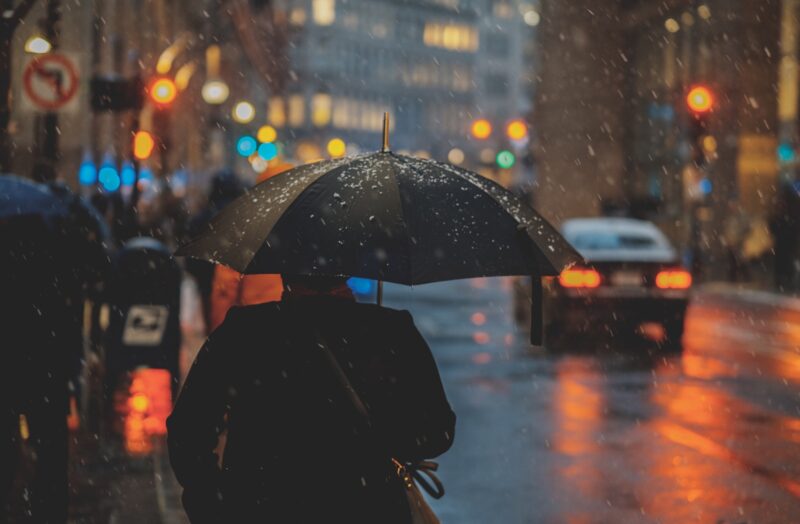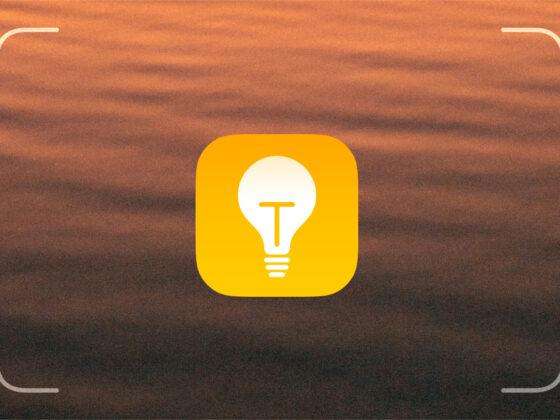Maybe you love taking photos in the rain. Or maybe you love taking photos, and it just happens to be raining. Either way, any photographer needs to know a bit about rain photography on iPhone. Here are some tips for shooting rain photos, capturing raindrops, and getting creative when the weather takes a turn.
Shooting rain photos with an iPhone
Ominous weather that is cloudy, wet, and threatening is actually perfect for rain photography, provided that you don’t mind the possibility of getting wet.
How do you take photos of rain without getting your phone wet?
The first thing you should know is that your iPhone won’t mind getting wet as much as you might think. Even older models are water-resistant, and the iPhone 12 and later can withstand submersion in up to 6 meters of water for as long as 30 minutes.
Yes, your iPhone can survive the rain, but shooting with a wet lens and screen isn’t ideal. Keep a stash of lens wipes in a plastic bag in your pocket so you can wipe your lens before framing a shot, and invest in some extra gear to make rain photography more pleasant:
- An umbrella: Yes, the lowly umbrella is actually the best way to keep rain off your camera lens — as long as it isn’t too windy. As a bonus, you can actually use your umbrella as a colorful photo prop for rainy day photos.
- A waterproof phone case: You may not actually need it, but a waterproof phone case will make you feel better, won’t it?
- Rain slicker: Keeping your phone dry won’t do much if you are soaking wet. Invest in a rain jacket with taped seams. And make sure the pockets are waterproof, too.
How to capture raindrops
Taking photos in the rain doesn’t require any serious photography skills. It’s more of a creative endeavor, challenging you to create interesting compositions based on what you find. There are a few things that will make your rain photography better, though. Here are a few tips, settings, and extra gear that might help:
- Shoot with a macro lens: Using the iPhone 13 or newer for photography? You already have a built-in macro lens that is perfect for capturing close-ups or reflections in raindrops. If you don’t have macro functionality, it’s worth investing in an external macro lens.
- Use the AF/AE lock: Lock in your focus and exposure settings before tapping the shutter. This takes only a second and will ensure that your photo is tack-sharp. Simply hold your finger down on the screen until a yellow box appears around the area of focus. Drag the sun icon up to increase the exposure or down to decrease it. Now tap the shutter.
- Use a slow shutter speed: If you’re caught in a downpour and want to capture the essence of the rain coming down in sheets, you will need a third-party app that will slow your shutter speed. Lightroom for mobile has a built-in camera that allows you to set your shutter speed to stay open for a longer period of time. 1/10 or 1/15 of a second should be suitable for most rain photos.
Rain photography ideas: What to photograph when it’s raining
This is where rain photography gets exciting. Even the most humdrum scenes can be filled with drama during a rainstorm. Suddenly, the world you knew is unrecognizable and fresh. If you’re having trouble figuring out what to take photos of when it rains, check out the ideas below and then create your own!
1. Take reflection photos in puddles and raindrops
You can use any type of water to take stunning reflection photos. If you have a macro lens, look for reflections in the tiniest raindrops. If you’re using a standard iPhone lens, try shooting reflections in puddles. There are endless creative opportunities for reflection shots during and after a rainstorm — it’s just a matter of getting out there and seeing what you can find.
2. Photograph the rain through a window
Don’t want to get wet this time around? Try capturing the rain through the window of your home or car (not while you’re driving, obviously). This is a great technique for abstract images, even if you can’t get the focus just right. Look for patterns in the raindrops and bright colors outside the window for the most interesting results. If this is a fall photography session, the colorful foliage will make the perfect backdrop.
3. Capture the rain at night
Photographing the rain at night can be challenging, but you can get some great shots, provided you find a good artificial light source and use Night mode if you have it. Streetlights, car headlights, or other city lights will work well to highlight the rain, even if your subject isn’t entirely in focus.
4. Photograph the movement of the water
Whether you’re capturing images of a toddler splashing in mud puddles, a dog shaking the rain off its fur, or raindrops falling from the sky, the motion of water is mesmerizing. To freeze the action of moving water, use Burst mode on your iPhone. To gently blur the water, use a manual camera app and a long shutter speed.
5. Capture the moodiness of the sky
When it comes to rain photography, the rain itself is only part of your composition. Rainy days make for cool cloud formations, lens flares, and rainbows. The secret is patience. You never know when the sun is going to peek out from behind a cloud and bathe the world in light. No two sky photos will ever be the same.
Tips for improving your rain photography
Now that you’ve got some ideas of what to shoot in the rain, here are a few more tips for improving your rain photography with your iPhone.
1. Shoot the scene from ground level
When capturing images with our iPhones, most photographers tend to shoot at eye level. While this is certainly a safe and comfortable way to take photos, it’s by no means the most interesting. Try getting down low by kneeling or bending over and shooting across the ground or toward the sky. This new angle is sure to open up all kinds of cool composition ideas.
2. Get up high and look down
If you live in an urban area, it’s not too difficult to find vantage points that allow you to shoot down toward the ground from up high. You can stay dry and shoot from the window of a tall building or climb a few sets of stairs to capture the scene below. Even using a selfie stick and taking photos of the ground will yield interesting results.
3. Use a tripod to steady your hand
Using a tripod is always a good idea for photography, but it’s especially important for shooting in low-light conditions or when trying to capture movement. A small, portable tripod is easy to use and easy to transport, making it a great item to keep with you for rain photography.
4. Use Burst mode to capture movement
We’ve already touched on using Burst mode with your iPhone, and this is a great way to freeze the motion when capturing falling rain. To use Burst mode, simply frame your shot, hold your finger on the shutter button, and drag it to the left. Your iPhone will take a quick succession of shots, and you can choose your favorites later.
Perhaps you’ve heard the saying, “There’s no such thing as bad weather.” Well, as it turns out, the adage applies to photography as well. If you choose to look at the next rainy day as an opportunity for creative photography, you’ll be more excited to enjoy whatever the weather throws your way.



